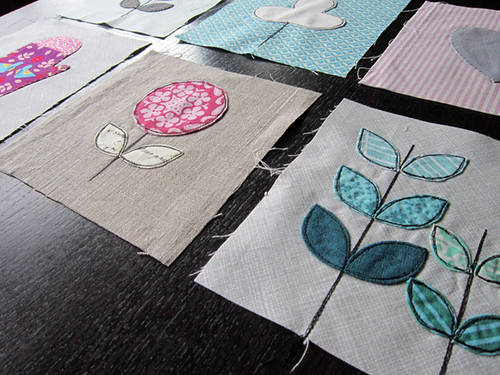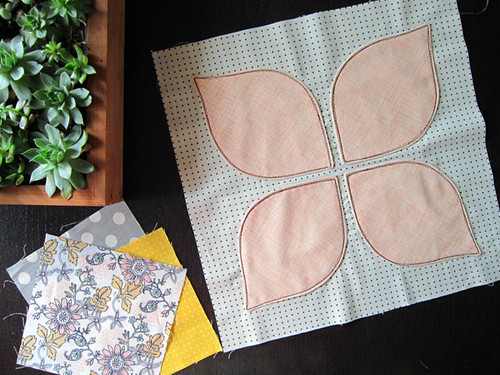why Applique?
Just one week away from registration. Yay! Lots to do, lots to do and lots to share! Today let's talk about machine applique, which is the first skill theme of the Penny Sampler class. Applique is fun and oh-so-useful. Let us count the ways...

The Penny Sampler quilt was inspired by Scandinavian style, coupled with my desire to hone small scale and illustrative sewing skills. Pencil and eraser in hand, I sketched and re-sketched the blocks of the Penny Sampler quilt and then studied how I could interpret the picture motifs via either applique or machine paper piecing. Since machine paper piecing builds only in straight lines, applique is nice for those shapes that really, really want to be curved.

For example, the heart. I know there are lots of pieced hearts, but applique is so much sweeter in my view, with the soft, even curves and sharp inner cleft.

Another great thing about applique is that it allows for unbroken fabrics. I love how Dilly Bird looks layered over that alphabet print. This large, directional print would not have the same impact if broken up as a background with piecing. Also, Little Bird's body is made up of a large scale print, fussy cut so that the change from teal to gray falls around the breast. Applique makes for delightful fabric play since fabric placement is so easy to control!
Have you ever sketched a design and then found yourself frustrated when trying to figure out how to piece it? Designs with lots of overlap can be a nightmare to piece... or even somewhat impossible, requiring y-seams and partial seams.

In such instances, applique can smooth out your path with amazing simplicity. Take this village, for example. I knew I wanted those roofs to overlap and nest together tightly. Rather than a ton of tricky piecing with triangles and split-backgrounds and even split buildings (because of all the necessary seams), I solved the problem by piecing the houses, but appliqueing the roofs. Aaaaaah..... happy sewing.
Concerned about raw edges or stiff applique paper? Worry not. There are lots of ways to applique, and I do enjoy them all, but in the Penny Sampler we're honing a specific set of skills. All of the projects are done with turned under edges for a no-fray, machine-washable quilt. We are not using fusible web. I'll be teaching two primary ways of creating applique shapes with turned under edges and how to know when each method is best to use.

I'm a real fan of attaching by machine with sketch stitch embroidery, as I shown on the clover, sunflower and vine blocks. It's super secure and pretty fool-proof. Really - it's so much easier than you think!

Sketch stitch embroidery can also be used to "draw" elements like these stems. But sketch stitching isn't the only option. In our class, I'll also demonstrate one method for attaching by hand, in case you want to do so. I attached the mitten block by hand for variety.

Later this week I'll be showing you my dogwood blossom applique quilt, which is one of the independent practice projects for applique in the Penny Sampler class. I think you're going to love it! I'm really smitten!!!
Any questions?

The Penny Sampler quilt was inspired by Scandinavian style, coupled with my desire to hone small scale and illustrative sewing skills. Pencil and eraser in hand, I sketched and re-sketched the blocks of the Penny Sampler quilt and then studied how I could interpret the picture motifs via either applique or machine paper piecing. Since machine paper piecing builds only in straight lines, applique is nice for those shapes that really, really want to be curved.

For example, the heart. I know there are lots of pieced hearts, but applique is so much sweeter in my view, with the soft, even curves and sharp inner cleft.

Another great thing about applique is that it allows for unbroken fabrics. I love how Dilly Bird looks layered over that alphabet print. This large, directional print would not have the same impact if broken up as a background with piecing. Also, Little Bird's body is made up of a large scale print, fussy cut so that the change from teal to gray falls around the breast. Applique makes for delightful fabric play since fabric placement is so easy to control!
Have you ever sketched a design and then found yourself frustrated when trying to figure out how to piece it? Designs with lots of overlap can be a nightmare to piece... or even somewhat impossible, requiring y-seams and partial seams.

In such instances, applique can smooth out your path with amazing simplicity. Take this village, for example. I knew I wanted those roofs to overlap and nest together tightly. Rather than a ton of tricky piecing with triangles and split-backgrounds and even split buildings (because of all the necessary seams), I solved the problem by piecing the houses, but appliqueing the roofs. Aaaaaah..... happy sewing.
Concerned about raw edges or stiff applique paper? Worry not. There are lots of ways to applique, and I do enjoy them all, but in the Penny Sampler we're honing a specific set of skills. All of the projects are done with turned under edges for a no-fray, machine-washable quilt. We are not using fusible web. I'll be teaching two primary ways of creating applique shapes with turned under edges and how to know when each method is best to use.

I'm a real fan of attaching by machine with sketch stitch embroidery, as I shown on the clover, sunflower and vine blocks. It's super secure and pretty fool-proof. Really - it's so much easier than you think!

Sketch stitch embroidery can also be used to "draw" elements like these stems. But sketch stitching isn't the only option. In our class, I'll also demonstrate one method for attaching by hand, in case you want to do so. I attached the mitten block by hand for variety.

Later this week I'll be showing you my dogwood blossom applique quilt, which is one of the independent practice projects for applique in the Penny Sampler class. I think you're going to love it! I'm really smitten!!!
Any questions?